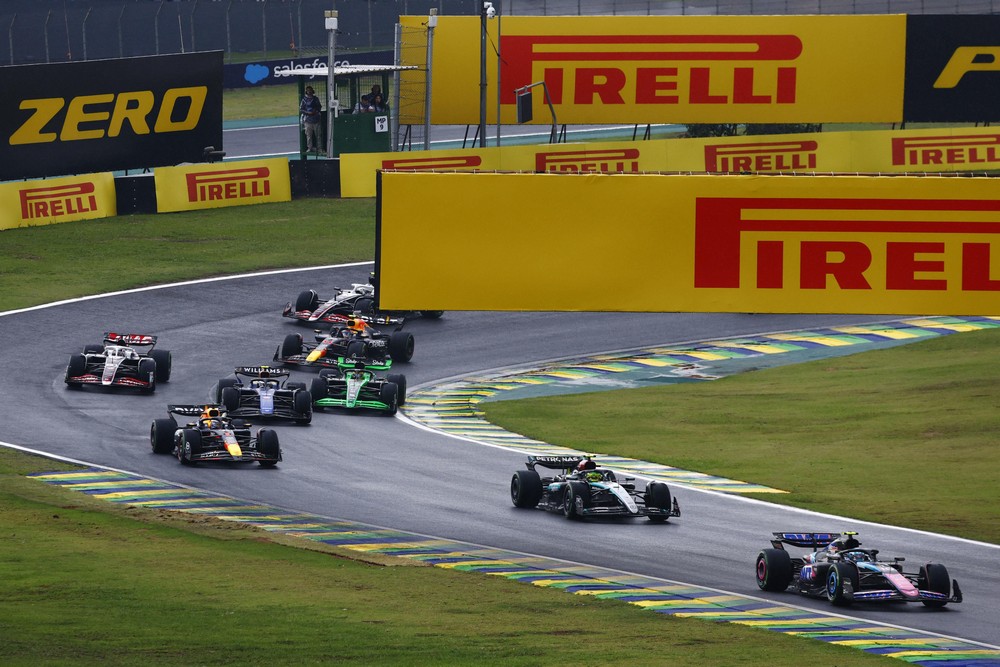
Charles Leclerc has been issued a €10,000 fine for swearing during the post-race press conference at last weekend’s Mexican Grand Prix. When asked about his thoughts during his late-race oversteer, he replied, “I had one oversteer and then when I recovered from that oversteer, I had an oversteer from the other side and then I was like, ‘f**k’.” The stewards discussed the incident, which violates the FIA International Sporting Code, eventually issuing a fine. Half of the fine is suspended, meaning that half will not need to be paid as long as Leclerc does not commit a similar violation. This punishment is notably less than Max Verstappen’s punishment for a similar incident. The stewards agreed that Leclerc’s violation was less severe than Verstappen’s, claiming that Leclerc was immediately apologetic and that he was answering a “somewhat leading question”.
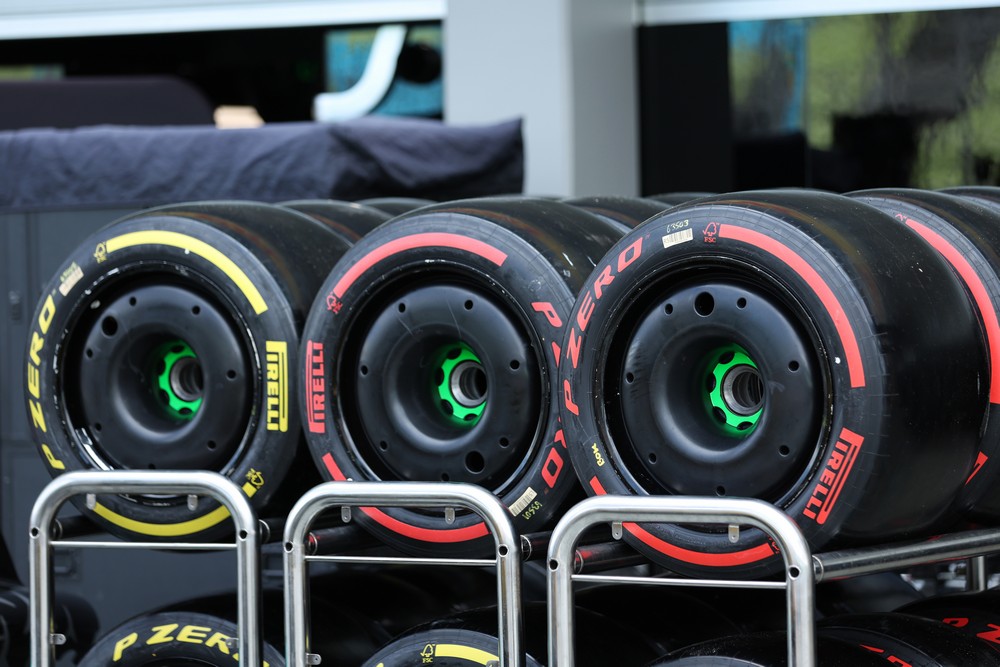
Red Bull has accused many teams of illegally cooling the tyres by inserting small amounts of fluid into the tyre, prompting a probe by the FIA. This is only one of many cheating allegations made this season, joining the mini-DRS and bib adjustment controversies. In both cases, neither of the involved teams were found guilty. Red Bull claims that the teams participating in this practice, including McLaren, could be doing so to cool the tyre from the inside. The current regulations state that tyres can only be inflated with air or nitrogen, but not restrict adding moisture to the tyres. Instead, the regulations prevent teams from removing moisture from the tyres, which would give the tyres better pressure. However, a technical directive previously issued by the FIA prohibits teams from adding moisture to the tyres. Tyres were more strictly inspected in Brazil to note any potential violators. The FIA has not commented on its findings.
Honda and Alpine have agreed to pay fines totalling $1m for engine cost cap breaches in 2023. Honda will pay $600,000 for “failure to file accurate Reporting Documentation” because their documents included “incorrect excluded and/or adjusted costs in the calculation”. Similarly, Alpine will pay $400,000 for submitting their documents late and “inaccurate by omitting relevant information”. The FIA found no evidence that either company acted in bad faith or attempted to gain an advantage. The fines reached via an Accepted Breach Agreement in early October, will need to be paid within 30 days.
Mercedes’ upgrade package is more or less set in stone this weekend, with no room remaining in this year’s budget cap for more development work on the car. This unexpected decreased development budget is largely due to Andrea Kimi Antonelli’s crash during practice for the Italian Grand Prix and George Russell’s crashes in United States Grand Prix qualifying and Mexican Grand Prix practice. “We have certain limitation on parts where we need to be creative how we’re managing them,” explained team principal Toto Wolff. “And certainly there is an impact on how many development parts we can put on the car, because the answer is zero.” Three race weekends remain in the season, including a sprint race in Qatar.
Red Bull switched Sergio Perez’s chassis ahead of the Brazilian Grand Prix, at the request of the driver. It is part of a hunt for answers to explain Perez’s dip in form. It is not a new chassis, having been used at other races earlier in the season. Additionally, Perez’s car will not be fitted with the new Red Bull floor that is currently being used by Max Verstappen. The team hopes to introduce the new floor to Perez’s car ahead of the Las Vegas Grand Prix.
Sauber has announced a management shuffle, which includes the signing of former Ferrari head of race strategy and sporting director Inaki Rueda. Rueda, who has worked for teams like Jordan, Renault, Lotus, and Ferrari, will become Sauber’s new Sporting Director. He takes this position from long-time Sauber employee Beat Zehnder, who will be changing roles to become Director of Signature Programs and Operations in 2025. Additionally, the team has recruited Giampaolo Dall’Ara to the newly created role of Head of Racing Engineering. Dall’Ara has previously worked with Alfa Romeo’s DTM team and also runs a consultancy firm.
Fernando Alonso arrived late to the Brazilian Grand Prix weekend for a medical issue. The 43-year-old Spaniard travelled back to Europe after the Mexican Grand Prix for treatment for an intestinal infection. He also missed media day for last weekend’s Mexican Grand Prix for medical reasons. Alonso didn’t miss any running during either weekend, although he complained about back pain at the bumpy Interlagos Circuit.
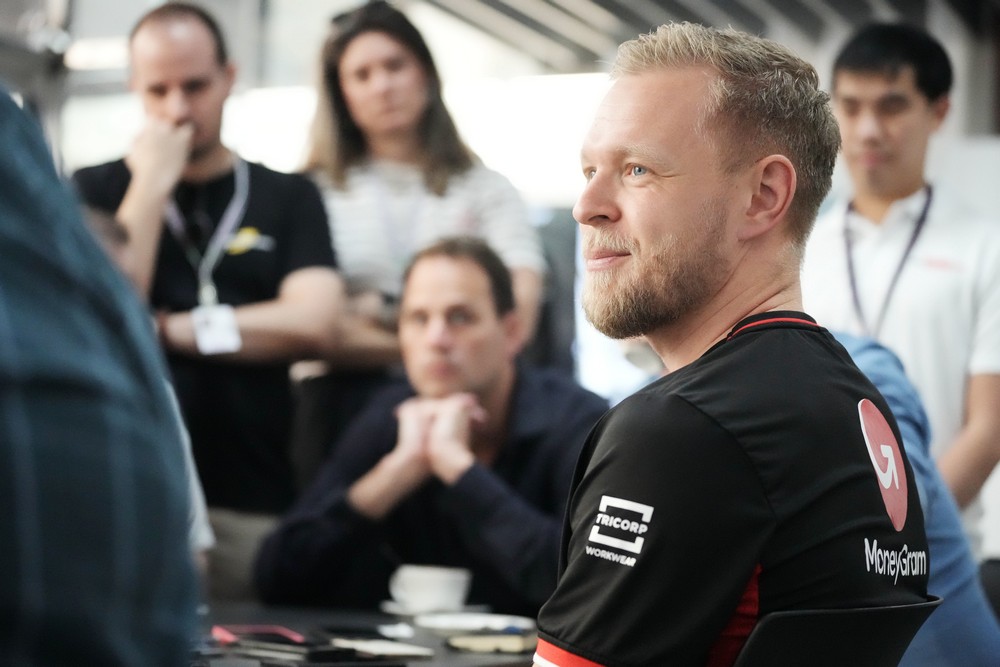
Kevin Magnussen was forced to sit out the Brazilian Grand Prix weekend after falling ill. Oliver Bearman filled in for the nauseous Dane, starting his third F1 race this season. On a normal race weekend, Haas would have liked Magnussen to return to the car on Saturday, but sprint qualifying is held on Friday, forcing the team to race Bearman. Magnussen is expected to return to action in Las Vegas. Bearman had a solid weekend, although he failed to collect any points and struggled with multiple spins during a wet race on Sunday. His third race start now means that he is no longer eligible to participate in the post-season test in Abu Dhabi as a rookie, as originally planned. The team will need to find another rookie to participate in the test.
With only one practice session available for the entire weekend, the teams and drivers were eager to get started on Friday morning. The session was led by Lando Norris in dry conditions, ahead of George Russel and Oliver Bearman, who impressed as a substitute in the Haas seat. Max Verstappen, who took a grid penalty for the race after an engine change, led the session early on before dropping to P15 as times improved.
Oscar Piastri took pole position for the sprint race, narrowly ahead of his teammate by only 0.029s. Lando Norris topped a relatively orderly SQ1 as well as SQ2. Lewis Hamilton and Sergio Perez were the two shock exits from SQ2, finishing P11 and P13 respectively. Piastri set the early pace in SQ3 but was out-paced by his teammate. Piastri took back the fastest time in the closing stages of the session. Charles Leclerc and Max Verstappen earned positions on the second row, behind the McLaren front row lockout.
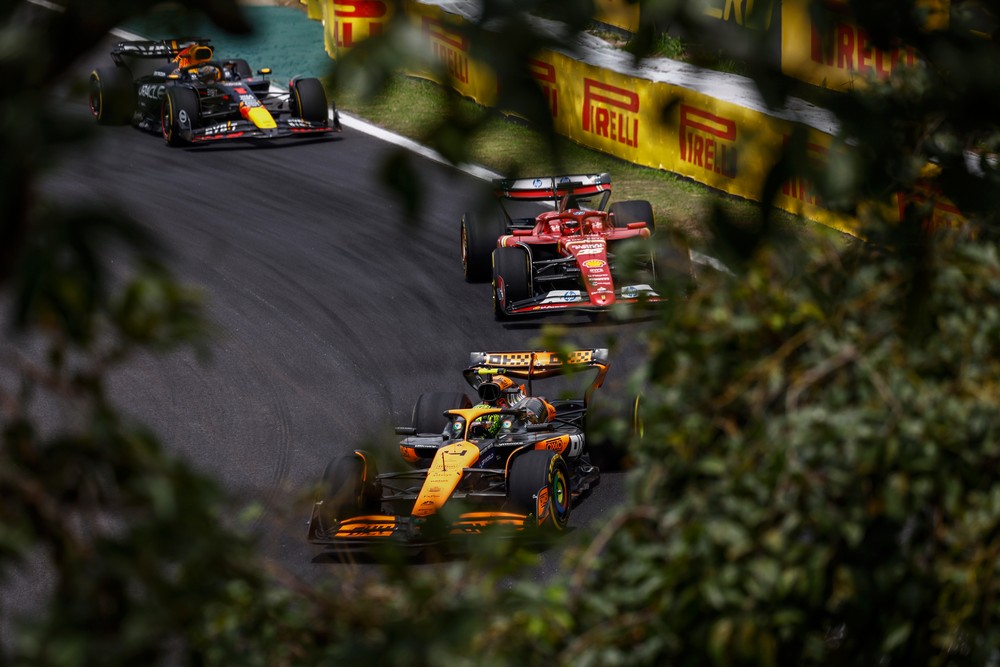
McLaren converted a front-row lockout into a 1-2 finish in the sprint race, although with the order inverted. Both McLarens had the early lead, with Oscar Piastri maintaining the early lead over his teammate while Max Verstappen found himself stuck behind Charles Leclerc. Lando Norris called for the early position swap, but the team declined. Eventually, Norris fell out of DRS range from his teammate and into the attacking range of Leclerc. Piastri slowed to pull Norris out of DRS range, which was good timing as Verstappen finally made it past Leclerc. A late VSC for a mechanical failure of Nico Hulkenberg’s Haas effectively eliminated any chance of Verstappen challenging the two McLarens, with McLaren opting for the driver swap just minutes before the VSC was deployed. Verstappen attempted to anticipate the end of the VSC to line up an overtake into turn four but was unsuccessful and was penalized after the race for exceeding the time delta, dropping him off the podium. Click here to read a full summary of the sprint race.
Qualifying for the main event was postponed until Sunday morning due to heavy rain that hit the circuit after Saturday’s sprint race. Rainy conditions caused a chaotic qualifying session, which would end with Lando Norris claiming the pole position. Conditions were only good enough for full wets in Q1, with only Valtteri Bottas brave enough to try the intermediate tyres briefly. The session was red-flagged when Franco Colapinto spun his Williams into the barrier. Max Verstappen set the fastest time in Q1, while Norris was nearly eliminated, just managing to bump out Lewis Hamilton for P15. The reigning World Champion would get eliminated in Q2 after a late red flag for Lance Stroll’s crash prevented either Red Bull driver from improving their time. Stroll was the second red flag of the session, with Carlos Sainz bringing out the red flag earlier. Oscar Piastri started the session on the intermediate tyres, leading the rest of the field to trade in their full wets. The rain began to fall again for Q3, causing a queue at the start of the session. The session was stopped when Fernando Alonso hit the barriers. The final red flag was flown for Alex Albon, who suffered a heavy crash which would ultimately force him to withdraw from the race due to damage. Norris was able to set the fastest time when the session resumed for the final time, lining up alongside George Russell on the front row. The dramatic circumstances of qualifying put some cars out of their usual positions. Yuki Tsunoda earned a career-best P3 starting position, with Esteban Ocon finishing an equally impressive P4.
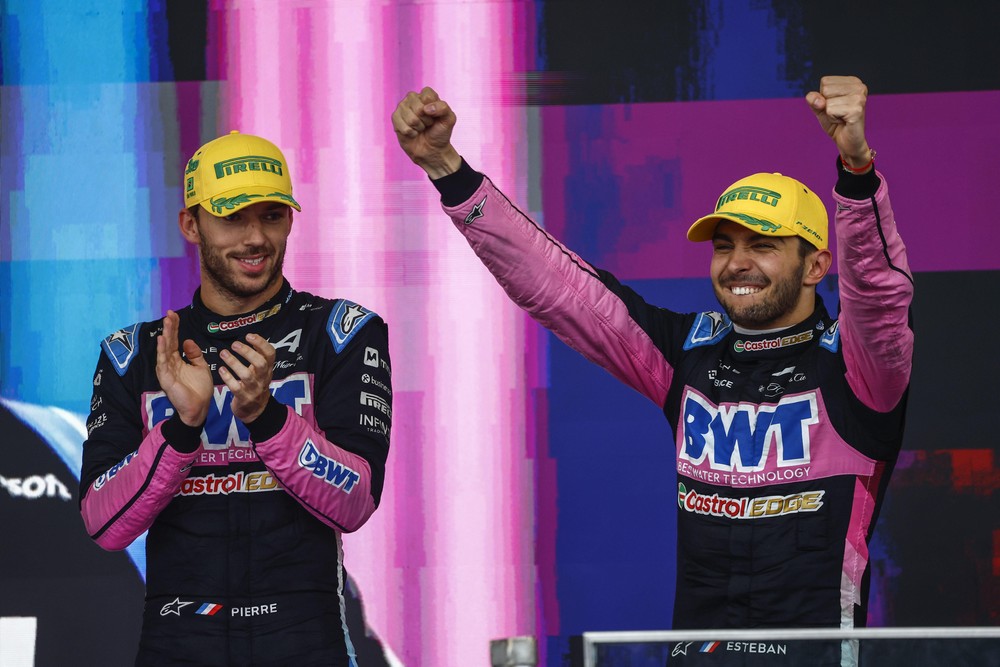
Sunday’s race, which was moved ahead by 90 minutes to avoid inclement weather, got off to a rocky start. Lance Stroll spun on the formation lap and then beached himself after trying to drive across the gravel. Race control aborted the start, confusing the grid as Lando Norris and George Russell started another formation lap. This was against the starting procedure, leading to post-race fines for both drivers and a second aborted start. After a slight delay, the race started after a third successful formation lap. Russell had a strong start, taking the lead in the first corner. Rain fell early in the race and the VSC was deployed after Nico Hulkenberg spun, getting himself stuck on the old banking at the first corner. Many drivers pitted for new intermediate tyres under the VSC, with a couple of them gambling on the full wets. It turned out to be a bad call, as the safety car was deployed for bad weather only a few laps later and then red-flagged when Franco Colapinto crashed under the safety car. When the race was resumed, Esteban Ocon led the way in front of Max Verstappen, who had made great progress from his P17 starting position. Neither driver had pitted under the VSC. Ocon maintained the lead but lost it to Verstappen on a second restart after Carlos Sainz crashed. Verstappen spent the rest of the race increasing his lead and setting fastest laps while both Alpine drivers hung onto P2 and P3 for a double podium finish. Click here to read a full summary of this chaotic race.
After the race, Mercedes was given two €5,000 fines for lowering the tyre pressures of both cars while on the grid for the third start attempt. Tyre pressures cannot be adjusted after the tyres are fitted to the car and this procedure was not followed by the Mercedes team. Although this offence would typically result in a disqualification from the event, the stewards went easy on the team, citing grid access issues. Mercedes argued that the circuit layout, short restart notice, and delayed opening of the grid to team members made it impossible for the team to follow the technical requirements. In the stewards’ statement, it was made clear that this penalty is not a new precedent, but rather a decision made for unique circumstances.
After the race, the stewards investigated multiple drivers for a starting procedure violation after the aborted start. After Lance Stroll spun during the formation lap, the start was aborted. The procedure dictates that drivers must remain on the grid after the aborted start message is displayed. In confusion, Lando Norris started a second formation lap when the message was displayed and other drivers followed. Some drivers remained on the grid but the race director eventually directed all teams to perform another formation lap. Lando Norris and George Russell were both fined €5,000 for the violation, while Yuki Tsunoda and Liam Lawson were not punished as they were determined to be “not predominately responsible for the breach” and they had only followed the actions of the drivers on the front row of the grid. The decision is likely to be a controversial one, as similar violations would typically warrant a 5 or 10-second penalty.
After a tiring triple-header stint that included two sprint races, everyone will have a couple of weeks to recuperate as we prepare to head into the final triple-header stretch of the season. Next on the calendar is the Las Vegas Grand Prix under the lights at the iconic Las Vegas Strip on Saturday, November 23.
It can be challenging for even the most avid fans to keep up with the fast-paced world of Formula One. The Weekly F1 Recap is a series published each Monday that breaks down the action, both on and off the circuit, into bit-sized pieces. It's perfect for casual and experienced fans alike.